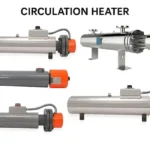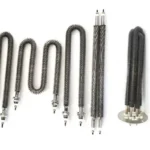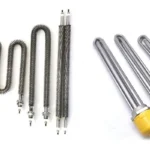An Ultimate Guide to the Tubular Immersion Heater

Table of Contents
What Is a Tubular Immersion Heater?
What is the main function of a tubular immersion heater?
A tubular immersion heater is an electric device with tube-shaped elements. It heats liquids or gases by being placed directly inside them. Its main job is to transfer heat efficiently. Because the heat is generated inside the liquid, almost all electricity becomes heat, making this method very efficient.
How does a tubular immersion heater work?
The heater works by passing electricity through a special resistance wire, which causes the wire to get hot. This heat moves to the outer metal tube (the sheath) and then directly into the surrounding liquid. A temperature controller turns the heater on and off to keep the liquid at a steady, precise temperature.
What Are the Components of a Tubular Immersion Heater?
What are tubular immersion heater elements?
Tubular immersion heater elements are the core heating parts. They are metal tubes that contain a heating coil. A key feature is their flexibility; they can be bent into many shapes, like U-bends or coils, to fit different tanks and ensure even heating.
What is the sheath and what materials are used?
The sheath is the heater's outer tube. It protects the internal parts and transfers heat to the liquid. The sheath material is chosen based on the liquid it will be in to prevent corrosion. Common materials are copper for clean water, steel for oils, and stainless steel or titanium for corrosive solutions.
What is the resistance wire?
The resistance wire, usually made of a nickel-chromium alloy, is the component that gets hot when electricity passes through it. It is wound into a coil to provide even heat along the length of the tube.
What is the insulation material?
Magnesium Oxide (MgO) powder is tightly packed inside the tube, between the sheath and the resistance wire. It is a good heat conductor but a poor electrical conductor. This allows heat to escape while keeping the heater electrically safe.
What are terminals and fittings?
Terminals are the points where electrical wires connect to the heater. Fittings are the parts used to mount the heater in a tank, such as a screw plug or a flange.
What Are the Types of Tubular Immersion Heaters?
What is a flanged immersion heater?
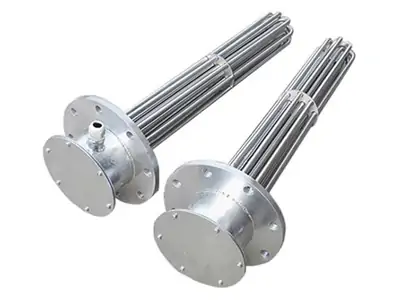
A flanged heater is for large tanks, especially those under pressure. It has many heating elements attached to a large flange, which is bolted onto the tank wall.
What is a screw plug immersion heater?
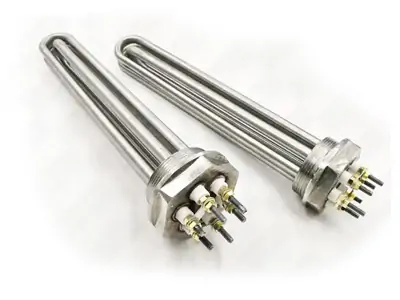
A screw plug heater is for smaller tanks. It has one or more elements attached to a threaded plug that screws into an opening in the tank, making it easy to install.
What is an over-the-side immersion heater?
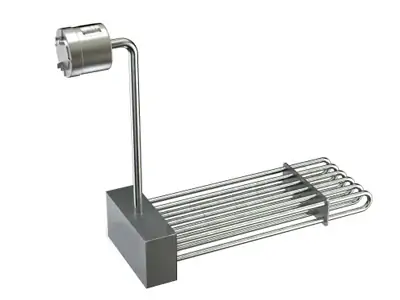
This type is for open-top tanks. It hangs over the edge of the tank, so no tank modifications are needed. It is portable and easy to remove for cleaning.
What is a circulation heater?
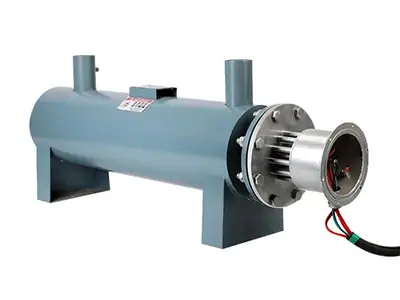
Also called an in-line heater, this device heats fluids as they flow through a pipe. The heater is contained within an insulated chamber with an inlet and outlet.
What are other configurations of tubular immersion heater elements?
- L-Shaped or Bottom Heaters: These are over-the-side heaters bent to lie on the tank bottom, which is ideal for low liquid levels.
- Finned Tubular Heaters: These elements have fins to increase their surface area, making them better for heating air and gases.
| Heater Type | Installation Method | Typical Pressure | Common Applications | Key Benefit |
|---|---|---|---|---|
| Flanged Heater | Bolted to a matching flange on the tank wall | High Pressure | Large tanks, pressurized vessels, heating oil, water, chemicals | High power capacity; good for pressurized systems |
| Screw Plug Heater | Screwed into a threaded opening in the tank wall | Low to Medium Pressure | Small to medium tanks, freeze protection, labs, food processing | Simple installation and easy replacement |
| Over-the-Side Heater | Hung over the top edge of an open tank | Atmospheric (No Pressure) | Open-top vats, plating solutions, cleaning chemicals | Portable; no tank changes needed |
| Circulation Heater | Installed in-line within a piping system | High Pressure | Heating flowing liquids and gases, fuel oil heating | Heats fluids as they move; very efficient |
Where Are Tubular Immersion Heaters Used?
Tubular heaters are used in many industries, including oil and gas, chemical processing, food and beverage, and power generation. Common uses include heating water, controlling oil viscosity, and freeze protection.
What Are the Advantages of a Tubular Immersion Heater?
- Efficiency: Nearly 100% of electrical energy is converted directly to heat in the liquid.
- Durability: They are built with strong materials and have no moving parts, so they last a long time.
- Safety: There is no open flame or exhaust, making them safer than fuel-burning heaters.
- Control: They offer very precise temperature control when used with sensors.
How Do You Select the Right Tubular Immersion Heater?
Choosing the right heater involves three key factors: sheath material, watt density, and required wattage.
How do you choose the correct sheath material?
The sheath material must resist corrosion from the liquid being heated. Heat makes corrosion happen faster, so the choice is critical. Manufacturers provide charts to help select the right material for different chemicals and temperatures.
| Sheath Material | Max Temp (Air) | Typical Applications | Corrosion Notes |
|---|---|---|---|
| Copper | 350°F (175°C) | Clean, potable water heating | Good for clean water, but corrodes in many other liquids. |
| Steel | 750°F (400°C) | Oils, glycol, non-corrosive fluids | Good for oils. Will rust in water. |
| 304 Stainless Steel | 1200°F (650°C) | Process water, food equipment, some mild corrosives | Better than steel. Not for chlorinated water. |
| 316 Stainless Steel | 1200°F (650°C) | Deionized water, more corrosive solutions | Better corrosion resistance than 304 SS. |
| Incoloy® 800/840 | 1600°F (870°C) | Air heating, high-temp process water, many corrosives | Excellent resistance to high temperatures and corrosion. |
| Inconel® 600 | 1800°F (980°C) | Highly corrosive acids, salts, and high-temp gases | Superior strength and resistance at high temperatures. |
| Titanium | Not rated for air | Highly corrosive acids, seawater | Excellent resistance to many acids. |
| PTFE (Teflon®) Coated | ~450°F (232°C) | Extremely corrosive acids and chemicals | A non-reactive coating over a metal sheath for best protection. |
What is watt density and why is it important?
Watt density is the heater's power output per square inch of its surface ($W/in^2$). If the watt density is too high for the liquid, it can burn the liquid or the heater. Water can handle a high watt density, but thick fluids like oil require a low watt density.
| Liquid / Medium | Max. Watt Density ($W/in^2$) | Key Considerations |
|---|---|---|
| Clean Water | 60 - 90 | Can handle high watt densities. |
| Process Water / Mild Solutions | 23 - 48 | Hard water can cause scale buildup. Lower watt density reduces this. |
| Light Oils / Heat Transfer Fluids | 20 - 25 | Needs lower density than water to prevent overheating. |
| Heavy / Viscous Oils | 5 - 15 | Low watt density is needed to prevent coking and failure. |
| Sugar Syrups / Molasses | ~5 | Very low watt density is needed to prevent scorching. |
| Highly Corrosive Solutions | 15 - 23 | Lower watt densities can slow down corrosion. |
How do you determine the required wattage?
The required wattage is the total power needed to heat the liquid in a certain amount of time. The calculation depends on the volume of liquid, the temperature change needed, and any heat lost from the tank. Manufacturers often provide online calculators to help determine the correct wattage.
Summary of Tubular Immersion Heaters
A tubular immersion heater is an efficient electric device that heats liquids by direct contact using its tubular immersion heater elements. It works by converting electricity to heat inside a protective metal sheath. The main parts are the sheath, a resistance wire, and insulation.
Heaters come in several types, including flanged, screw plug, and over-the-side, to fit different tanks and applications. They are valued for their high efficiency, durability, safety, and precise control. Proper selection requires choosing the right sheath material, watt density, and total wattage for the specific liquid and process.


